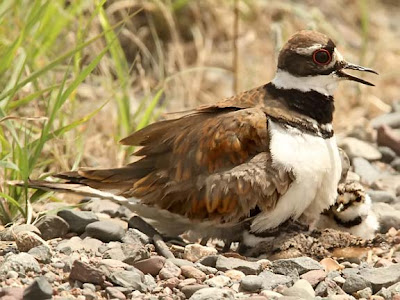Killdeer will sometimes nest in wetlands finding a slightly elevated dry spot for the nest. They have also been observed nesting on the gravel roofs of buildings, which can be disastrous.The typical clutch size for killdeer is four to six eggs. The eggs are incubated for three to four weeks. The eggs are buff colored with many speckles which makes them look like stones. When the chicks hatch they already have a covering of down feathers and are able to leave the nest and begin foraging right away. Even though this chick was way to young to fly it still could run quite quickly and was an expert at hiding in the lily pads.
Although they are a shore bird killdeer are often found away from water in parks, farm fields, golf courses and along gravel roads. When a predator shows up near the nest or young the adult bird will often fake a wing injuring to try to lure the predator away. When the predator is far enough away from the nest or young or if it gets to close the adult will give up the rouse and fly away. This does not stop animals like cows that are not interested in eating the adult. In these cases the bird will puff itself up as large as possible and charge the larger animal, hoping to get it to change its path. The bird in the photo above is faking a broken wing.




























 Dragonflies are not so harmonious. As a predator, taking their prey is totally one sided. Do not judge them harshly though, for many things that they prey on, flies and mosquitoes for example, are considered pests.
Dragonflies are not so harmonious. As a predator, taking their prey is totally one sided. Do not judge them harshly though, for many things that they prey on, flies and mosquitoes for example, are considered pests.





















